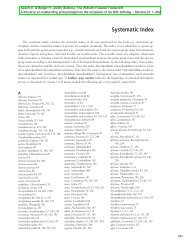abstracts der vorträge und poster - Technisches Büro für Ökologie
abstracts der vorträge und poster - Technisches Büro für Ökologie
abstracts der vorträge und poster - Technisches Büro für Ökologie
Erfolgreiche ePaper selbst erstellen
Machen Sie aus Ihren PDF Publikationen ein blätterbares Flipbook mit unserer einzigartigen Google optimierten e-Paper Software.
Hödl Iris, Dep. Freshwater Ecology, Uni.Vienna; iris.hoedl@univie.ac.at<br />
Hödl Josef, Helenenstrasse 73, 2500 Baden; josef@hoedl.cc<br />
Singer Gabriel, Dep. Freshwater Ecology, Uni.Vienna; gabriel.singer@univie.ac.at<br />
Besemer, Katharina, Dep. Freshwater Ecology, katharina.besemer@univie.ac.at<br />
Battin, Tom, WasserCluster Lunz GmbH, 3293 Lunz am See; tom.battin@univie.ac.at<br />
INTERACTIONS GENERATE NON-RANDOM SPATIAL DISTRIBUTION OF LOW-<br />
ABUNDANCE CELLS DURING INITIAL BIOFILM FORMATION<br />
Spatial configuration plays a f<strong>und</strong>amental role in defining the structural and functional properties of<br />
biological systems, therefore it is of paramount importance to quantify the spatial organization of<br />
these systems. In this study, we investigated the spatial configuration of post-adhesive nonreproducing<br />
cells in a nascent stream biofilm. We conducted experiments in artificial streams<br />
continuously fed with natural streamwater and contained inoculum where we exposed sterile slides to<br />
microhabitats exposed to different flow environments. Attached cells were monitored microscopically<br />
over 12 hours for their spatial arrangement using Voronoi tessellation. This is a geometrical method<br />
that partitions space between attached cells by assigning space to the nearest neighboring cells,<br />
resulting in an area-wide coverage with concave polygons. We fo<strong>und</strong> that already after 0.5 h the<br />
distribution of cells significantly differed from uniform-random distribution, and did so increasingly<br />
over 12 h. Using a simple mechanistic model assuming cell-cell signalling and chemical surface<br />
conditioning as candidate mechanisms, we could simulated the deviation from uniform-random<br />
Hörtnagl, Paul, Inst. <strong>für</strong> <strong>Ökologie</strong>, Universität Innsbruck, paul.hoertnagl@uibk.ac.at<br />
Pérez, Maria, Teresa, Inst. <strong>für</strong> <strong>Ökologie</strong>, Universität Innsbruck, maria.perez@uibk.ac.at<br />
Sommaruga, Ruben, Inst. <strong>für</strong> <strong>Ökologie</strong>, Universität Innsbruck, ruben.sommaruga@uibk.ac.at<br />
EFFECT OF ULTRAVIOLET RADIATION ON THE GROWTH EFFICIENCY OF<br />
FRESHWATER BACTERIAL ISOLATES<br />
Five bacterial strains of the taxonomical groups Alphaproteobacteria, Betaproteobacteria,<br />
Gammaproteobacteria, and Actinobacteria were isolated from different freshwater habitats and used to<br />
test the effect of ultraviolet radiation (UVR) on heterotrophic bacterial production, respiration, and<br />
growth efficiency. Bacterial carbon production (BCP) was assessed by measuring leucine bulk<br />
incorporation rates, whereas bacterial respiration (BR) was calculated from oxygen consumption rates<br />
after exposing the strains to simulated PAR and PAR+UVR for 4 hours. Although BCP was not<br />
significantly different between the dark control and the PAR treatment, it decreased significantly after<br />
exposure to the PAR+UVR treatment in three out of five strains. Moreover, BR rates of two strains<br />
also decreased significantly after exposure to PAR+UVR. The bacterial growth efficiency of the<br />
different strains ranged between 0.2% and 42.3% un<strong>der</strong> dark conditions. In three out of five strains,<br />
the BGE was significantly lower after exposure to PAR+UV than in the dark, but it increased<br />
significantly in one strain. Our results indicate that freshwater bacterial strains strongly differ in their<br />
BGE and that UVR can inhibit as well as stimulate their growth efficiencies.<br />
17



